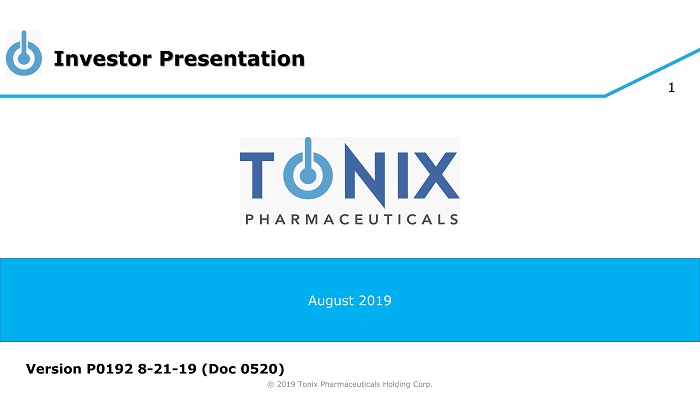
Tonix Pharmaceuticals Holding Corp. 8-K
Exhibit 99.02

© 2019 Tonix Pharmaceuticals Holding Corp. 1 August 2019 Version P0192 8 - 21 - 19 (Doc 0520) Investor Presentation
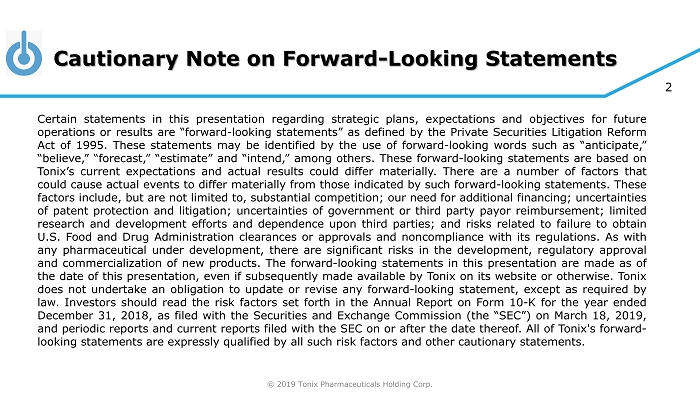
© 2019 Tonix Pharmaceuticals Holding Corp. 2 Cautionary Note on Forward - Looking Statements Certain statements in this presentation regarding strategic plans, expectations and objectives for future operations or results are “forward - looking statements” as defined by the Private Securities Litigation Reform Act of 1995 . These statements may be identified by the use of forward - looking words such as “anticipate,” “believe,” “forecast,” “estimate” and “intend,” among others . These forward - looking statements are based on Tonix’s current expectations and actual results could differ materially . There are a number of factors that could cause actual events to differ materially from those indicated by such forward - looking statements . These factors include, but are not limited to, substantial competition ; our need for additional financing ; uncertainties of patent protection and litigation ; uncertainties of government or third party payor reimbursement ; limited research and development efforts and dependence upon third parties ; and risks related to failure to obtain U . S . Food and Drug Administration clearances or approvals and noncompliance with its regulations . As with any pharmaceutical under development, there are significant risks in the development, regulatory approval and commercialization of new products . The forward - looking statements in this presentation are made as of the date of this presentation, even if subsequently made available by Tonix on its website or otherwise . Tonix does not undertake an obligation to update or revise any forward - looking statement, except as required by law . Investors should read the risk factors set forth in the Annual Report on Form 10 - K for the year ended December 31 , 2018 , as filed with the Securities and Exchange Commission (the “SEC”) on March 18 , 2019 , and periodic reports and current reports filed with the SEC on or after the date thereof . All of Tonix's forward - looking statements are expressly qualified by all such risk factors and other cautionary statements .
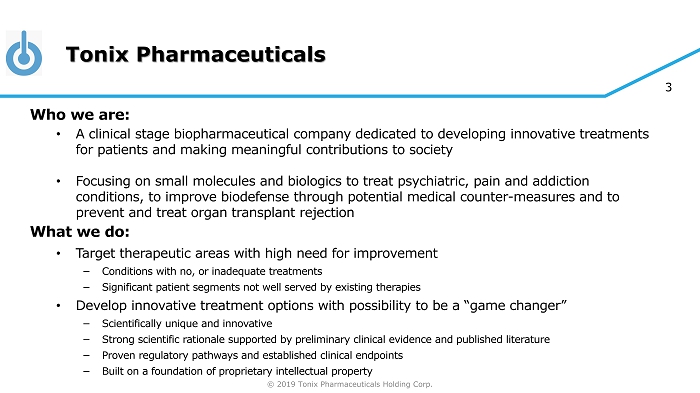
© 2019 Tonix Pharmaceuticals Holding Corp. 3 Tonix Pharmaceuticals Who we are: • A clinical stage biopharmaceutical company dedicated to developing innovative treatments for patients and making meaningful contributions to society • Focusing on small molecules and biologics to treat psychiatric, pain and addiction conditions, to improve biodefense through potential medical counter - measures and to prevent and treat organ transplant rejection What we do: • Target therapeutic areas with high need for improvement − Conditions with no, or inadequate treatments − Significant patient segments not well served by existing therapies • Develop innovative treatment options with possibility to be a “game changer” − Scientifically unique and innovative − Strong scientific rationale supported by preliminary clinical evidence and published literature − Proven regulatory pathways and established clinical endpoints − Built on a foundation of proprietary intellectual property
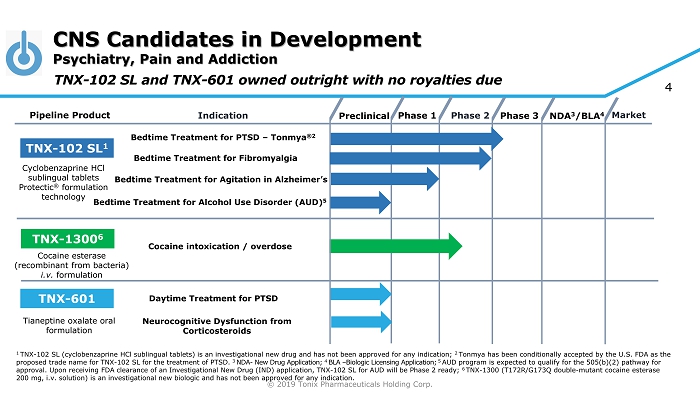
© 2019 Tonix Pharmaceuticals Holding Corp. 4 CNS Candidates in Development Psychiatry, Pain and Addiction Preclinical Phase 2 NDA 3 /BLA 4 Market Pipeline Product Indication Phase 3 TNX - 102 SL 1 Bedtime Treatment for PTSD – Tonmya ®2 Daytime Treatment for PTSD TNX - 601 TNX - 1300 6 Cocaine intoxication / overdose Cyclobenzaprine HCl sublingual tablets Protectic ® formulation technology Tianeptine oxalate oral formulation Cocaine esterase (recombinant from bacteria) i.v. formulation Phase 1 Bedtime Treatment for Fibromyalgia TNX - 102 SL and TNX - 601 owned outright with no royalties due Bedtime Treatment for Agitation in Alzheimer’s Neurocognitive Dysfunction from Corticosteroids Bedtime Treatment for Alcohol Use Disorder (AUD) 5 1 TNX - 102 SL (cyclobenzaprine HCl sublingual tablets) is an investigational new drug and has not been approved for any indication; 2 Tonmya has been conditionally accepted by the U.S. FDA as the proposed trade name for TNX - 102 SL for the treatment of PTSD. 3 NDA - New Drug Application; 4 BLA – Biologic Licensing Application; 5 AUD program is expected to qualify for the 505(b)(2) pathway for approval. Upon receiving FDA clearance of an Investigational New Drug (IND) application, TNX - 102 SL for AUD will be Phase 2 read y; 6 TNX - 1300 (T172R/G173Q double - mutant cocaine esterase 200 mg, i.v. solution) is an investigational new biologic and has not been approved for any indication.
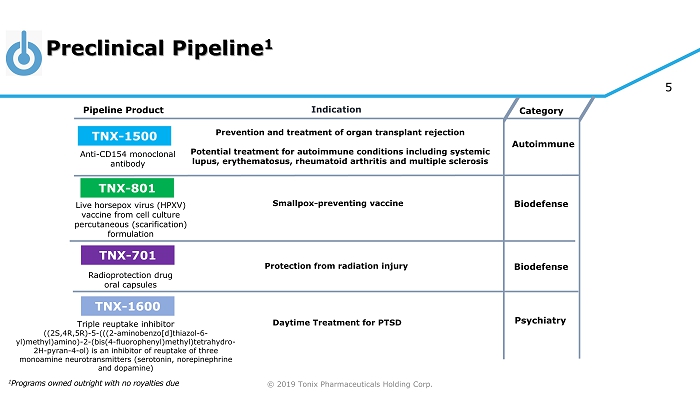
© 2019 Tonix Pharmaceuticals Holding Corp. 5 Preclinical Pipeline 1 1 Programs owned outright with no royalties due Category Pipeline Product Indication TNX - 801 Smallpox - preventing vaccine Live horsepox virus (HPXV) vaccine from cell culture percutaneous (scarification) formulation TNX - 701 Protection from radiation injury Radioprotection drug oral capsules Biodefense TNX - 1600 Triple reuptake inhibitor ((2S,4R,5R) - 5 - (((2 - aminobenzo[d]thiazol - 6 - yl)methyl)amino) - 2 - (bis(4 - fluorophenyl)methyl)tetrahydro - 2H - pyran - 4 - ol) is an inhibitor of reuptake of three monoamine neurotransmitters (serotonin, norepinephrine and dopamine) Daytime Treatment for PTSD Biodefense Psychiatry TNX - 1500 Anti - CD154 monoclonal antibody Prevention and treatment of organ transplant rejection Potential treatment for autoimmune conditions including systemic lupus, erythematosus, rheumatoid arthritis and multiple sclerosis Autoimmune
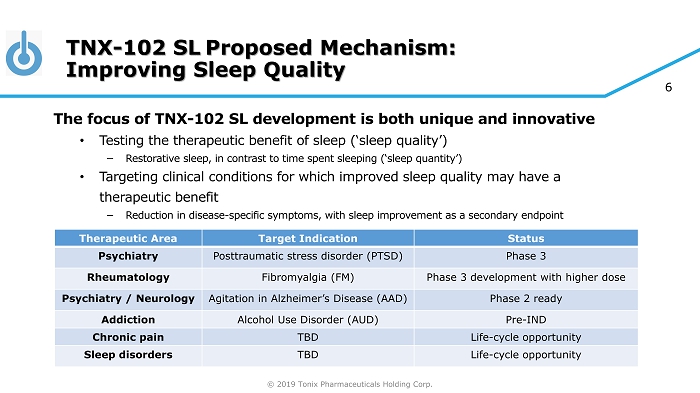
© 2019 Tonix Pharmaceuticals Holding Corp. 6 The focus of TNX - 102 SL development is both unique and innovative • Testing the therapeutic benefit of sleep (‘sleep quality’) − Restorative sleep, in contrast to time spent sleeping (‘sleep quantity’) • Targeting clinical conditions for which improved sleep quality may have a therapeutic benefit − Reduction in disease - specific symptoms, with sleep improvement as a secondary endpoint Therapeutic Area Target Indication Status Psychiatry Posttraumatic stress disorder (PTSD) Phase 3 Rheumatology Fibromyalgia (FM) Phase 3 development with higher dose Psychiatry / Neurology Agitation in Alzheimer’s Disease (AAD) Phase 2 ready Addiction Alcohol Use Disorder (AUD) Pre - IND Chronic pain TBD Life - cycle opportunity Sleep disorders TBD Life - cycle opportunity TNX - 102 SL Proposed Mechanism: Improving Sleep Quality
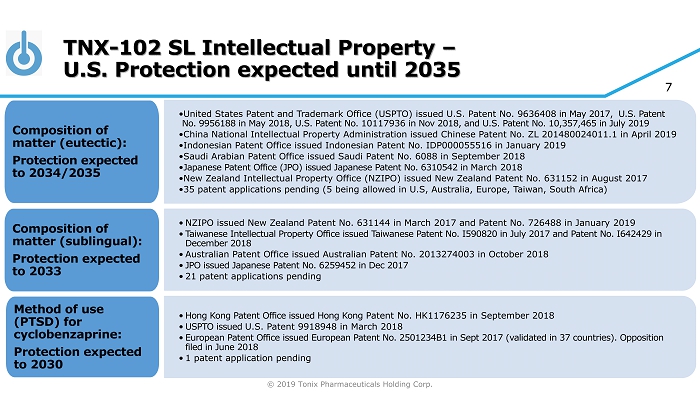
© 2019 Tonix Pharmaceuticals Holding Corp. 7 TNX - 102 SL Intellectual Property – U.S. Protection expected until 2035 • United States Patent and Trademark Office (USPTO) issued U.S. Patent No. 9636408 in May 2017, U.S. Patent No. 9956188 in May 2018, U.S. Patent No. 10117936 in Nov 2018, and U.S. Patent No. 10,357,465 in July 2019 • China National Intellectual Property Administration issued Chinese Patent No. ZL 201480024011.1 in April 2019 • Indonesian Patent Office issued Indonesian Patent No. IDP000055516 in January 2019 • Saudi Arabian Patent Office issued Saudi Patent No. 6088 in September 2018 • Japanese Patent Office (JPO) issued Japanese Patent No. 6310542 in March 2018 • New Zealand Intellectual Property Office (NZIPO) issued New Zealand Patent No. 631152 in August 2017 • 35 patent applications pending (5 being allowed in U.S, Australia, Europe, Taiwan, South Africa) Composition of matter (eutectic): Protection expected to 2034/2035 • NZIPO issued New Zealand Patent No. 631144 in March 2017 and Patent No. 726488 in January 2019 • Taiwanese Intellectual Property Office issued Taiwanese Patent No. I590820 in July 2017 and Patent No. I642429 in December 2018 • Australian Patent Office issued Australian Patent No. 2013274003 in October 2018 • JPO issued Japanese Patent No. 6259452 in Dec 2017 • 21 patent applications pending Composition of matter (sublingual): Protection expected to 2033 • Hong Kong Patent Office issued Hong Kong Patent No. HK1176235 in September 2018 • USPTO issued U.S. Patent 9918948 in March 2018 • European Patent Office issued European Patent No. 2501234B1 in Sept 2017 (validated in 37 countries). Opposition filed in June 2018 • 1 patent application pending Method of use (PTSD) for cyclobenzaprine: Protection expected to 2030
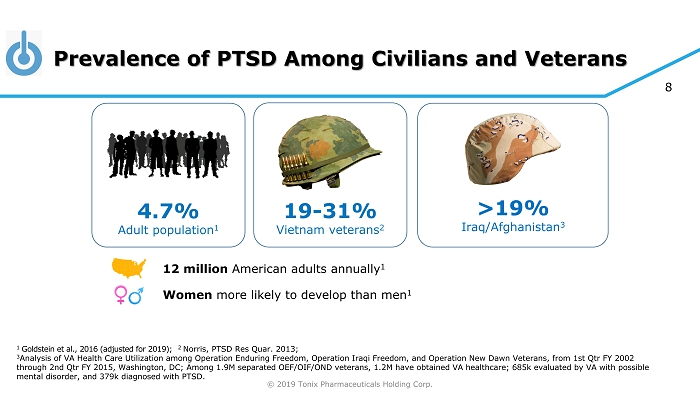
© 2019 Tonix Pharmaceuticals Holding Corp. 8 Prevalence of PTSD Among Civilians and Veterans 1 Goldstein et al., 2016 (adjusted for 2019) ; 2 Norris, PTSD Res Quar. 2013; 3 Analysis of VA Health Care Utilization among Operation Enduring Freedom, Operation Iraqi Freedom, and Operation New Dawn Vete ran s, from 1st Qtr FY 2002 through 2nd Qtr FY 2015, Washington, DC ; Among 1.9M separated OEF/OIF/OND veterans, 1.2M have obtained VA healthcare; 685k evaluated by VA with possible mental disorder, and 379k diagnosed with PTSD. >19% Iraq/Afghanistan 3 4.7% Adult population 1 19 - 31% Vietnam veterans 2 12 million American adults annually 1 Women more likely to develop than men 1
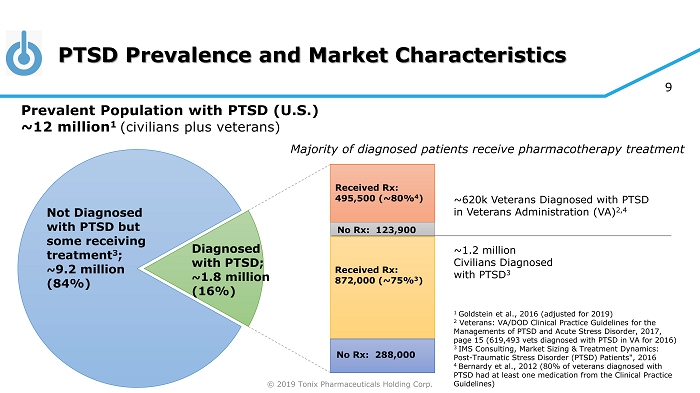
© 2019 Tonix Pharmaceuticals Holding Corp. 9 PTSD Prevalence and Market Characteristics 1 Goldstein et al., 2016 (adjusted for 2019) 2 Veterans: VA/DOD Clinical Practice Guidelines for the Managements of PTSD and Acute Stress Disorder, 2017, page 15 (619,493 vets diagnosed with PTSD in VA for 2016) 3 IMS Consulting, Market Sizing & Treatment Dynamics: Post - Traumatic Stress Disorder (PTSD) Patients", 2016 4 Bernardy et al., 2012 (80% of veterans diagnosed with PTSD had at least one medication from the Clinical Practice Guidelines) ~620k Veterans Diagnosed with PTSD in Veterans Administration (VA) 2,4 ~1.2 million Civilians Diagnosed with PTSD 3 Not Diagnosed with PTSD but some receiving treatment 3 ; ~ 9.2 million ( 84% ) Received Rx : 495,500 (~80% 4 ) No Rx : 123,900 Received Rx : 872,000 (~75% 3 ) No Rx : 288,000 Diagnosed with PTSD; ~ 1.8 million ( 16% ) Prevalent Population with PTSD (U.S.) ~12 million 1 (civilians plus veterans) Majority of diagnosed patients receive pharmacotherapy treatment
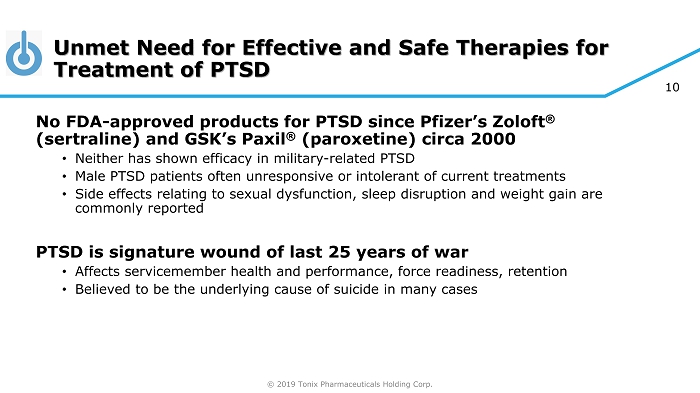
© 2019 Tonix Pharmaceuticals Holding Corp. 10 Unmet Need for Effective and Safe Therapies for Treatment of PTSD No FDA - approved products for PTSD since Pfizer’s Zoloft ® (sertraline) and GSK’s Paxil ® (paroxetine) circa 2000 • Neither has shown efficacy in military - related PTSD • Male PTSD patients often unresponsive or intolerant of current treatments • Side effects relating to sexual dysfunction, sleep disruption and weight gain are commonly reported PTSD is signature wound of last 25 years of war • Affects servicemember health and performance, force readiness, retention • Believed to be the underlying cause of suicide in many cases
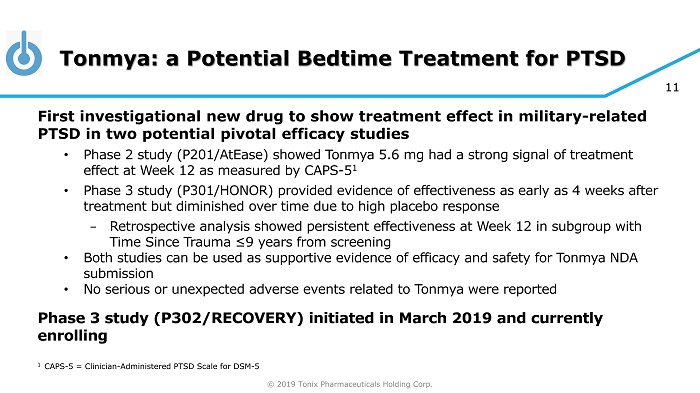
© 2019 Tonix Pharmaceuticals Holding Corp. 11 Tonmya : a Potential Bedtime Treatment for PTSD First investigational new drug to show treatment effect in military - related PTSD in two potential pivotal efficacy studies • Phase 2 study (P201/ AtEase ) showed Tonmya 5.6 mg had a strong signal of treatment effect at Week 12 as measured by CAPS - 5 1 • Phase 3 study (P301/HONOR) provided evidence of effectiveness as early as 4 weeks after treatment but diminished over time due to high placebo response − Retrospective analysis showed persistent effectiveness at Week 12 in subgroup with Time Since Trauma ≤9 years from screening • Both studies can be used as supportive evidence of efficacy and safety for Tonmya NDA submission • No serious or unexpected adverse events related to Tonmya were reported Phase 3 study (P302/RECOVERY) initiated in March 2019 and currently enrolling 1 CAPS - 5 = Clinician - Administered PTSD Scale for DSM - 5
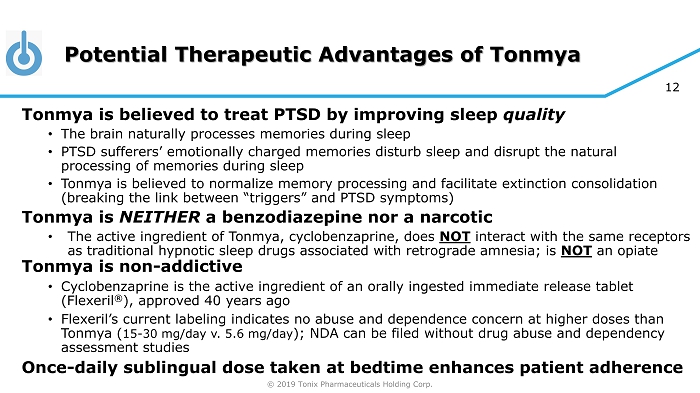
© 2019 Tonix Pharmaceuticals Holding Corp. 12 Potential Therapeutic Advantages of Tonmya Tonmya is believed to treat PTSD by improving sleep quality • The brain naturally processes memories during sleep • PTSD sufferers’ emotionally charged memories disturb sleep and disrupt the natural processing of memories during sleep • Tonmya is believed to normalize memory processing and facilitate extinction consolidation (breaking the link between “triggers” and PTSD symptoms) Tonmya is NEITHER a benzodiazepine nor a narcotic • The active ingredient of Tonmya , cyclobenzaprine, does NOT interact with the same receptors as traditional hypnotic sleep drugs associated with retrograde amnesia; is NOT an opiate Tonmya is non - addictive • Cyclobenzaprine is the active ingredient of an orally ingested immediate release tablet (Flexeril ® ), approved 40 years ago • Flexeril’s current labeling indicates no abuse and dependence concern at higher doses than Tonmya ( 15 - 30 mg/day v. 5.6 mg/day ); NDA can be filed without drug abuse and dependency assessment studies Once - daily sublingual dose taken at bedtime enhances patient adherence

© 2019 Tonix Pharmaceuticals Holding Corp. 13 Tonmya Phase 2 Dose - Effect in Military - Related PTSD 1 1 Completed Phase 2 P201/AtEase study: Retrospective analysis of Tonmya 5.6 mg on CAPS - 5 ≥33 (high - moderate) subgroup. Primary analysis of P 201/ AtEase , based on Tonmya 2.8 mg in participants with entry CAPS - 5 ≥29 ( moderate PTSD severity), was not statistically significant. 2 CAPS - 5 = Clinician administered PTSD Scale for DSM - 5 7.2 points ** p<0.01, * p<0.025, Tonmya 5.6 mg group with placebo, MMRM with multiple imputation (MI); * p=0.018, Tonmya 2.8 mg group with placebo, MMRM with MI PTSD Symptoms (CAPS - 5 2 Score) Remission = Loss of Diagnosis and CAPS - 5 < 11 Asterisk and hashmark represent pairwise comparisons between Tonmya and Placebo; # p=0.08, Odds Ratio 3.01 (0.89, 10.18) *p=0.02, Odds Ratio 4.60 (1.27, 16.66); logistic regression 5.20% 14.30% 21.10% 0% 5% 10% 15% 20% 25% 30% Weeks 8 & 12 Percent in Remission Placebo (N=77) Tonmya 2.8 mg (N=70) Tonmya 5.6 mg (N=38) # * Remission at Weeks 8 & 12
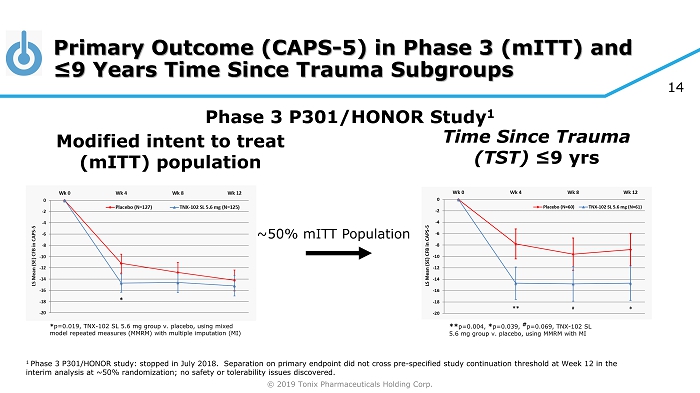
© 2019 Tonix Pharmaceuticals Holding Corp. 14 Primary Outcome (CAPS - 5) in Phase 3 ( mITT ) and ≤9 Years Time Since Trauma Subgroups Modified intent to treat ( mITT ) population Phase 3 P301/HONOR Study 1 ** p=0.004, * p=0.039, # p=0.069, TNX - 102 SL 5.6 mg group v. placebo, using MMRM with MI ~50% mITT Population * p=0.019, TNX - 102 SL 5.6 mg group v. placebo, using mixed model repeated measures (MMRM) with multiple imputation (MI) Time Since Trauma (TST) ≤9 yrs 1 Phase 3 P301/HONOR study: stopped in July 2018. Separation on primary endpoint did not cross pre - specified study continuation t hreshold at Week 12 in the interim analysis at ~50% randomization; no safety or tolerability issues discovered.
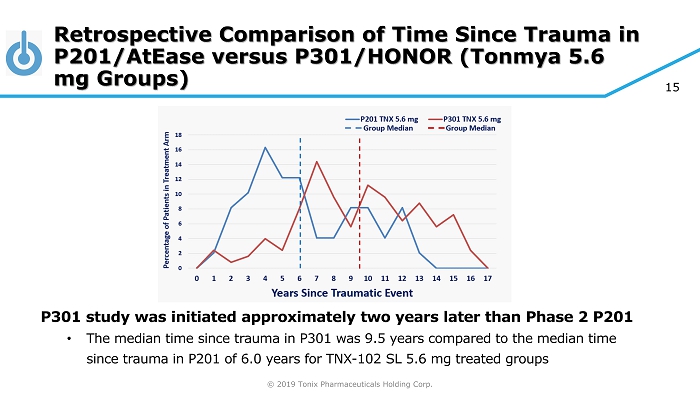
© 2019 Tonix Pharmaceuticals Holding Corp. 15 Retrospective Comparison of Time Since Trauma in P201/AtEase versus P301/HONOR (Tonmya 5.6 mg Groups) P301 study was initiated approximately two years later than Phase 2 P201 • The median time since trauma in P301 was 9.5 years compared to the median time since trauma in P201 of 6.0 years for TNX - 102 SL 5.6 mg treated groups
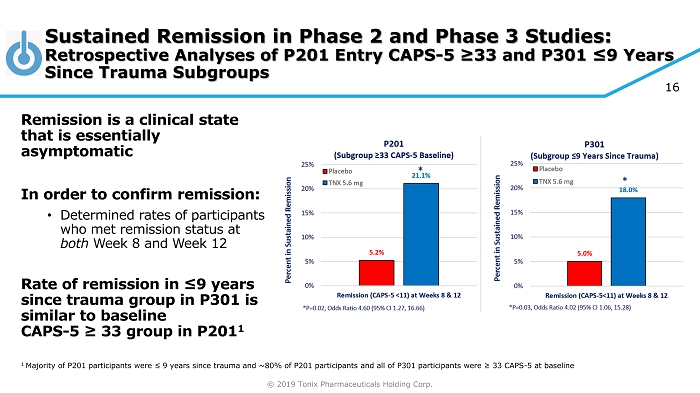
© 2019 Tonix Pharmaceuticals Holding Corp. 16 Sustained Remission in Phase 2 and Phase 3 Studies: Retrospective Analyses of P201 Entry CAPS - 5 ≥33 and P301 ≤9 Years Since Trauma Subgroups Remission is a clinical state that is essentially asymptomatic In order to confirm remission: • Determined rates of participants who met remission status at both Week 8 and Week 12 Rate of remission in ≤9 years since trauma group in P301 is similar to baseline CAPS - 5 ≥ 33 group in P201 1 1 Majority of P201 participants were ≤ 9 years since trauma and ~80% of P201 participants and all of P301 participants were ≥ 33 CAPS - 5 at baseline
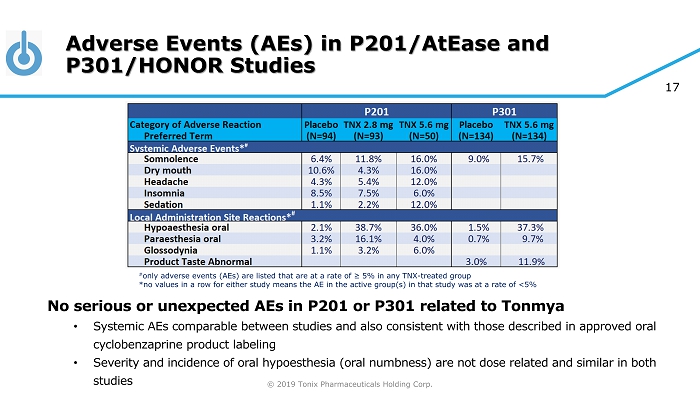
© 2019 Tonix Pharmaceuticals Holding Corp. 17 Adverse Events (AEs) in P201/AtEase and P301/HONOR Studies No serious or unexpected AEs in P201 or P301 related to Tonmya • Systemic AEs comparable between studies and also consistent with those described in approved oral cyclobenzaprine product labeling • Severity and incidence of oral hypoesthesia (oral numbness) are not dose related and similar in both studies # only adverse events (AEs) are listed that are at a rate of ≥ 5% in any TNX - treated group *no values in a row for either study means the AE in the active group(s) in that study was at a rate of <5%
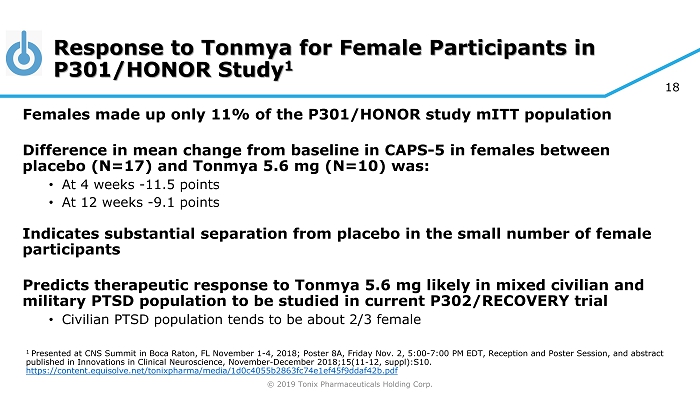
© 2019 Tonix Pharmaceuticals Holding Corp. 18 Response to Tonmya for Female Participants in P301/HONOR Study 1 Females made up only 11% of the P301/HONOR study mITT population Difference in mean change from baseline in CAPS - 5 in females between placebo (N=17) and Tonmya 5.6 mg (N=10) was: • At 4 weeks - 11.5 points • At 12 weeks - 9.1 points Indicates substantial separation from placebo in the small number of female participants Predicts therapeutic response to Tonmya 5.6 mg likely in mixed civilian and military PTSD population to be studied in current P302/RECOVERY trial • Civilian PTSD population tends to be about 2/3 female 1 Presented at CNS Summit in Boca Raton, FL November 1 - 4, 2018; Poster 8A, Friday Nov. 2, 5:00 - 7:00 PM EDT, Reception and Poster S ession, and abstract published in Innovations in Clinical Neuroscience, November - December 2018;15(11 - 12, suppl):S10. https://content.equisolve.net/tonixpharma/media/1d0c4055b2863fc74e1ef45f9ddaf42b.pdf

© 2019 Tonix Pharmaceuticals Holding Corp. 19 Non - combat traumas studied are similar to traumas experienced in civilian populations with PTSD To determine the therapeutic effects of Tonmya 5.6 mg in a mixed civilian and military population, difference in MCFB in CAPS - 5 was assessed in non - combat traumas in ≤9 years TST subgroup (placebo N=14, Tonmya 5.6 mg N=10): • At 4 weeks - 4.8 points • At 12 weeks - 4.4 points Non - combat traumas treated with Tonmya 5.6 mg showed clinically meaningful separation from placebo at Weeks 4 and 12, suggesting a mixed civilian and military sample within 9 years of index trauma may show a therapeutic response to Tonmya Response to Tonmya for Non - Combat Traumas in P301/HONOR Study in ≤9 Years Time Since Trauma Subgroup 1 1 Presented at CNS Summit in Boca Raton, FL November 1 - 4, 2018; Poster 8A, Friday Nov. 2, 5:00 - 7:00 PM EDT, Reception and Poster S ession, and abstract published in Innovations in Clinical Neuroscience, November - December 2018;15(11 - 12, suppl):S10. https://content.equisolve.net/tonixpharma/media/1d0c4055b2863fc74e1ef45f9ddaf42b.pdf CAPS - 5 = Clinician - Administered PTSD Scale for DSM - 5; MCFB = mean change from baseline; mITT = modified Intent - to - Treat sample; TST = time since trauma
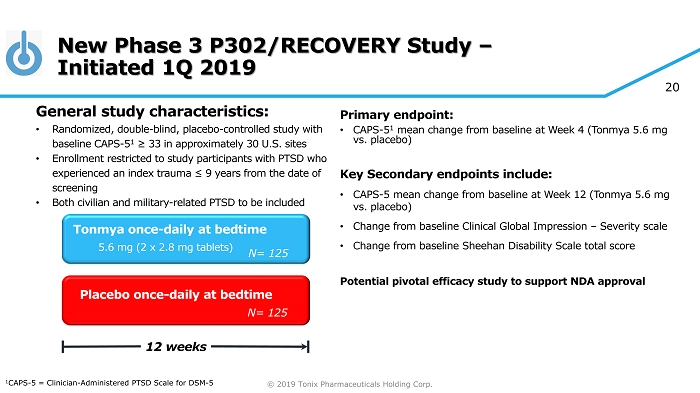
© 2019 Tonix Pharmaceuticals Holding Corp. 20 New Phase 3 P302/RECOVERY Study – Initiated 1Q 2019 Primary e ndpoint: • CAPS - 5 1 mean change from baseline at Week 4 ( Tonmya 5.6 mg vs. placebo) Key Secondary e ndpoint s include: • CAPS - 5 m ean change from baseline at W eek 12 (Tonmya 5.6 mg vs. placebo ) • Change from baseline Clinical Global Impression – Severity scale • Change from baseline Sheehan Disability Scale total score Potential pivotal efficacy study to support NDA approval Placebo once - daily at bedtime 12 weeks Tonmya once - daily at bedtime 5.6 mg (2 x 2.8 mg tablets) General s tudy c haracteristics: • Randomized, double - blind, placebo - controlle d study with baseline CAPS - 5 1 ≥ 33 in approximately 30 U.S. sites • Enrollment restricted to study participants with PTSD who experienced an index trauma ≤ 9 years from the date of screening • Both civilian and military - related PTSD to be included 1 CAPS - 5 = Clinician - Administered PTSD Scale for DSM - 5 N= 125 N= 125
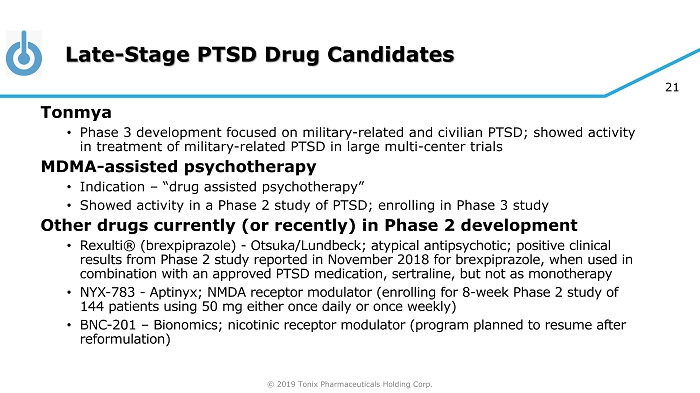
© 2019 Tonix Pharmaceuticals Holding Corp. 21 Late - Stage PTSD Drug Candidates Tonmya • Phase 3 development focused on military - related and civilian PTSD; showed activity in treatment of military - related PTSD in large multi - center trials MDMA - assisted psychotherapy • Indication – “drug assisted psychotherapy” • Showed activity in a Phase 2 study of PTSD; enrolling in Phase 3 study Other drugs currently (or recently) in Phase 2 development • Rexulti ® ( brexpiprazole ) - Otsuka/Lundbeck; atypical antipsychotic; positive clinical results from Phase 2 study reported in November 2018 for brexpiprazole , when used in combination with an approved PTSD medication, sertraline, but not as monotherapy • NYX - 783 - Aptinyx ; NMDA receptor modulator (enrolling for 8 - week Phase 2 study of 144 patients using 50 mg either once daily or once weekly) • BNC - 201 – Bionomics; nicotinic receptor modulator (program planned to resume after reformulation)
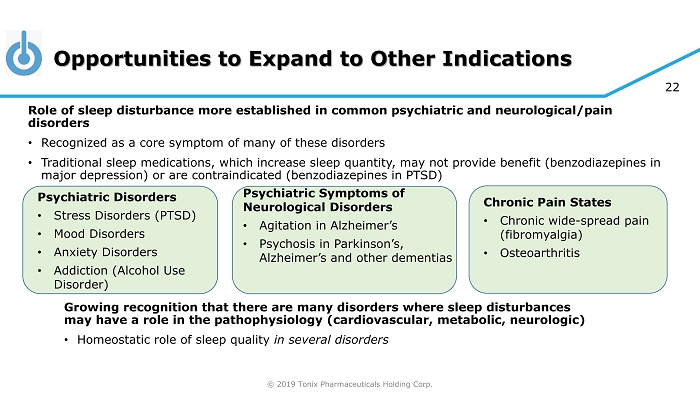
© 2019 Tonix Pharmaceuticals Holding Corp. 22 Opportunities to Expand to Other Indications Growing recognition that there are many disorders where sleep disturbances may have a role in the pathophysiology (cardiovascular, metabolic, neurologic) • Homeostatic role of sleep quality in several disorders Psychiatric Disorders • Stress Disorders (PTSD) • Mood Disorders • Anxiety Disorders • Addiction (Alcohol Use Disorder) Chronic Pain States • Chronic wide - spread pain (fibromyalgia) • Osteoarthritis Role of sleep disturbance more established in common psychiatric and neurological/pain disorders • Recognized as a core symptom of many of these disorders • Traditional sleep medications, which increase sleep quantity, may not provide benefit (benzodiazepines in major depression) or are contraindicated (benzodiazepines in PTSD) Psychiatric Symptoms of Neurological Disorders • Agitation in Alzheimer’s • Psychosis in Parkinson’s, Alzheimer’s and other dementias
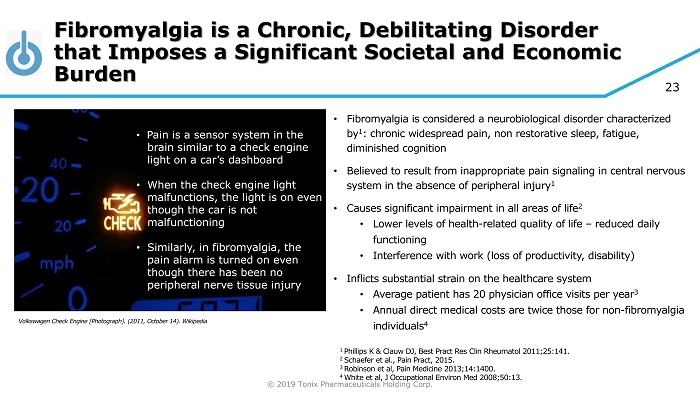
© 2019 Tonix Pharmaceuticals Holding Corp. 23 Volkswagen Check Engine [Photograph]. (2011, October 14). Wikipedia • Pain is a sensor system in the brain similar to a check engine light on a car’s dashboard • When the check engine light malfunctions, the light is on even though the car is not malfunctioning • Similarly, in fibromyalgia, the pain alarm is turned on even though there has been no peripheral nerve tissue injury • Fibromyalgia is considered a neurobiological disorder characterized by 1 : chronic widespread pain, non restorative sleep, fatigue, diminished cognition • Believed to result from inappropriate pain signaling in central nervous system in the absence of peripheral injury 1 • Causes significant impairment in all areas of life 2 • Lower levels of health - related quality of life – reduced daily functioning • Interference with work (loss of productivity, disability) • Inflicts substantial strain on the healthcare system • Average patient has 20 physician office visits per year 3 • Annual direct medical costs are twice those for non - fibromyalgia individuals 4 Fibromyalgia is a Chronic, Debilitating Disorder that Imposes a Significant Societal and Economic Burden 1 Phillips K & Clauw DJ, Best Pract Res Clin Rheumatol 2011;25:141. 2 Schaefer et al., Pain Pract , 2015. 3 Robinson et al, Pain Medicine 2013;14:1400. 4 White et al, J Occupational Environ Med 2008;50:13.
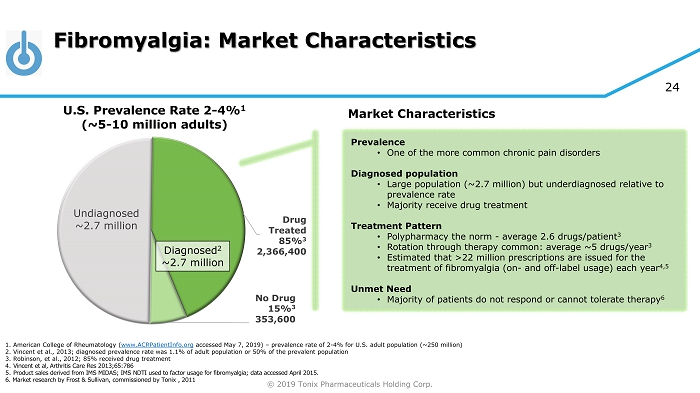
© 2019 Tonix Pharmaceuticals Holding Corp. 24 Fibromyalgia: Market Characteristics Undiagnosed ~2.7 million Drug Treated 85% 3 2,366,400 No Drug 15% 3 353,600 U.S. Prevalence Rate 2 - 4% 1 (~5 - 10 million adults) Diagnosed 2 ~2.7 million Market Characteristics Prevalence • One of the more common chronic pain disorders Diagnosed population • Large population (~2.7 million) but underdiagnosed relative to prevalence rate • Majority receive drug treatment Treatment Pattern • Polypharmacy the norm - average 2.6 drugs/patient 3 • Rotation through therapy common: average ~5 drugs/year 3 • Estimated that >22 million prescriptions are issued for the treatment of fibromyalgia (on - and off - label usage) each year 4,5 Unmet Need • Majority of patients do not respond or cannot tolerate therapy 6 1. American College of Rheumatology ( www.ACRPatientInfo.org accessed May 7, 2019) – prevalence rate of 2 - 4% for U.S. adult population (~250 million) 2. Vincent et al., 2013; diagnosed prevalence rate was 1.1% of adult population or 50% of the prevalent population 3. Robinson, et al., 2012; 85% received drug treatment 4. Vincent et al, Arthritis Care Res 2013;65:786 5. Product sales derived from IMS MIDAS; IMS NDTI used to factor usage for fibromyalgia; data accessed April 2015. 6. Market research by Frost & Sullivan, commissioned by Tonix , 2011
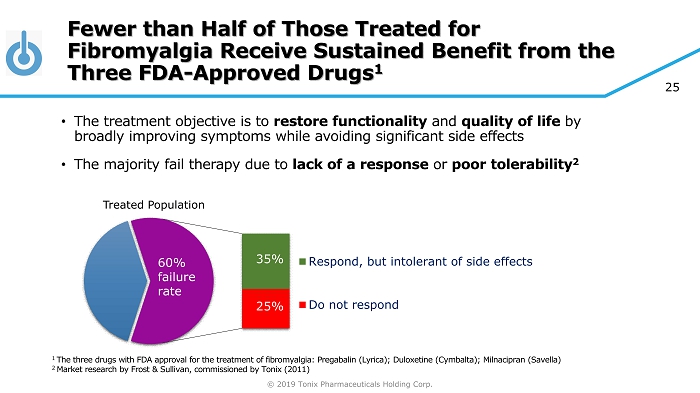
© 2019 Tonix Pharmaceuticals Holding Corp. 25 Fewer than Half of Those Treated for Fibromyalgia Receive Sustained Benefit from the Three FDA - Approved Drugs 1 • The treatment objective is to restore functionality and quality of life by broadly improving symptoms while avoiding significant side effects • The majority fail therapy due to lack of a response or poor tolerability 2 Respond, but intolerant of side effects Do not respond 25% 35% 60% failure rate 1 The three drugs with FDA approval for the treatment of fibromyalgia: Pregabalin (Lyrica); Duloxetine (Cymbalta); Milnacipran ( Savella ) 2 Market research by Frost & Sullivan, commissioned by Tonix (2011) Treated Population

© 2019 Tonix Pharmaceuticals Holding Corp. 26 Large Need for New Fibromyalgia Therapies that Provide Broad Symptom Improvement with Better Tolerability • Currently - approved medications may have side effects that limit long - term use 1 • Many patients skip doses or discontinue altogether within months of treatment initiation • Medication - related side effects may be similar to fibromyalgia symptoms • High rates of discontinuation, switching and augmentation • A ttempt to treat multiple symptoms and/or avoid intolerable side effects • Average of 2 - 3 medications used simultaneously 2 • The typical patient has tried six different medications 3 • Substantial off - label use of narcotic painkillers and prescription sleep aids 3 • Among those diagnosed, more than one - third have used prescription opioids as a means of treatment 4 • TNX - 102 SL is a non - opioid, centrally - acting analgesic that could provide a new therapeutic option for fibromyalgia patients 1 Nuesch et al, Ann Rheum Dis 2013;72:955 - 62. 2 Robinson RL et al, Pain Medicine 2012;13:1366. 3 Patient Trends: Fibromyalgia”, Decision Resources, 2011. 4 Berger A, Dukes E, Martin S, Edelsberg J, Oster G, Int J Clin Pract , 2007; 61(9):1498 – 1508.
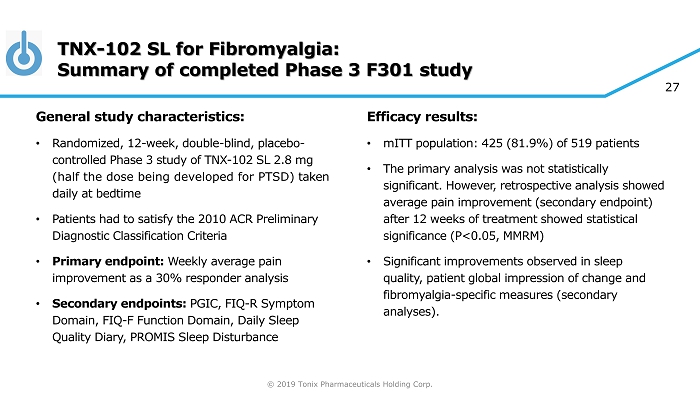
© 2019 Tonix Pharmaceuticals Holding Corp. 27 TNX - 102 SL for Fibromyalgia: Summary of completed Phase 3 F301 study General s tudy c haracteristics: • Randomized, 12 - week, double - blind, placebo - controlle d Phase 3 study of TNX - 102 SL 2.8 mg (half the dose being developed for PTSD) taken daily at bedtime • Patients had to satisfy the 2010 ACR Preliminary Diagnostic Classification Criteria • Primary endpoint: Weekly average pain improvement as a 30% responder analysis • Secondary endpoints: PGIC, FIQ - R Symptom Domain, FIQ - F Function Domain, Daily Sleep Quality Diary, PROMIS Sleep Disturbance Efficacy results: • mITT population: 425 (81.9%) of 519 patients • The primary analysis was not statistically significant. However, retrospective analysis showed average pain improvement (secondary endpoint) after 12 weeks of treatment showed statistical significance (P<0.05, MMRM) • Significant improvements observed in sleep quality, patient global impression of change and fibromyalgia - specific measures (secondary analyses).
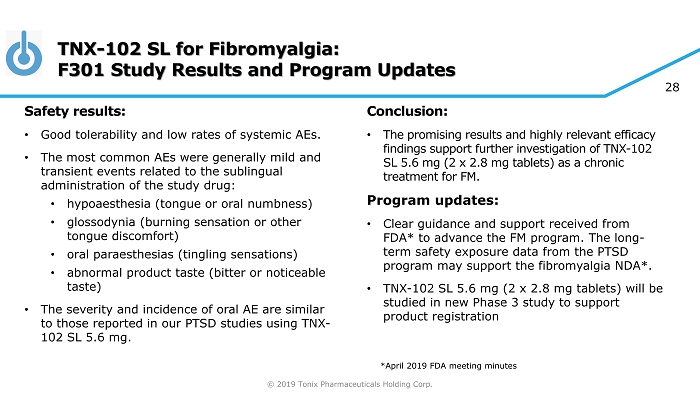
© 2019 Tonix Pharmaceuticals Holding Corp. 28 TNX - 102 SL for Fibromyalgia: F301 Study Results and Program Updates Safety results: • Good tolerability and low rates of systemic AEs. • The most common AEs were generally mild and transient events related to the sublingual administration of the study drug: • hypoaesthesia (tongue or oral numbness) • glossodynia (burning sensation or other tongue discomfort) • oral paraesthesias (tingling sensations) • abnormal product taste (bitter or noticeable taste) • The severity and incidence of oral AE are similar to those reported in our PTSD studies using TNX - 102 SL 5.6 mg. Conclusion: • The promising results and highly relevant efficacy findings support further investigation of TNX - 102 SL 5.6 mg (2 x 2.8 mg tablets) as a chronic treatment for FM. Program updates: • Clear guidance and support received from FDA* to advance the FM program. The long - term safety exposure data from the PTSD program may support the fibromyalgia NDA*. • TNX - 102 SL 5.6 mg (2 x 2.8 mg tablets) will be studied in new Phase 3 study to support product registration *April 2019 FDA meeting minutes
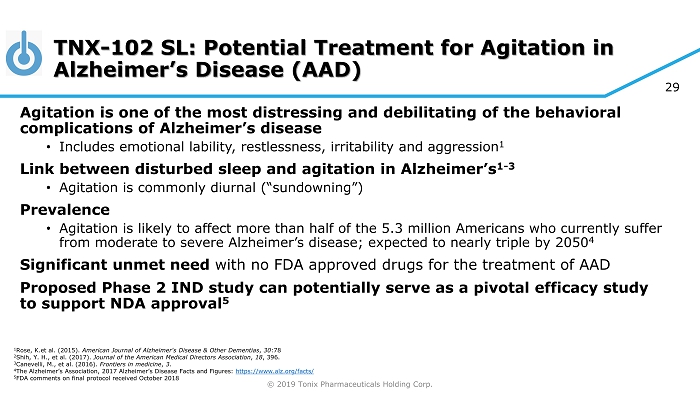
© 2019 Tonix Pharmaceuticals Holding Corp. 29 TNX - 102 SL: Potential Treatment for Agitation in Alzheimer’s Disease (AAD) Agitation is one of the most distressing and debilitating of the behavioral complications of Alzheimer’s disease • Includes emotional lability, restlessness, irritability and aggression 1 Link between disturbed sleep and agitation in Alzheimer’s 1 - 3 • Agitation is commonly diurnal (“ sundowning ”) Prevalence • Agitation is likely to affect more than half of the 5.3 million Americans who currently suffer from moderate to severe Alzheimer’s disease; expected to nearly triple by 2050 4 Significant unmet need with no FDA approved drugs for the treatment of AAD Proposed Phase 2 IND study can potentially serve as a pivotal efficacy study to support NDA approval 5 1 Rose, K.et al. (2015). American Journal of Alzheimer's Disease & Other Dementias , 30 :78 2 Shih, Y. H., et al. (2017). Journal of the American Medical Directors Association , 18 , 396. 3 Canevelli, M., et al. (2016). Frontiers in medicine , 3 . 4 The Alzheimer’s Association, 2017 Alzheimer’s Disease Facts and Figures: https://www.alz.org/facts/ 5 FDA comments on final protocol received October 2018
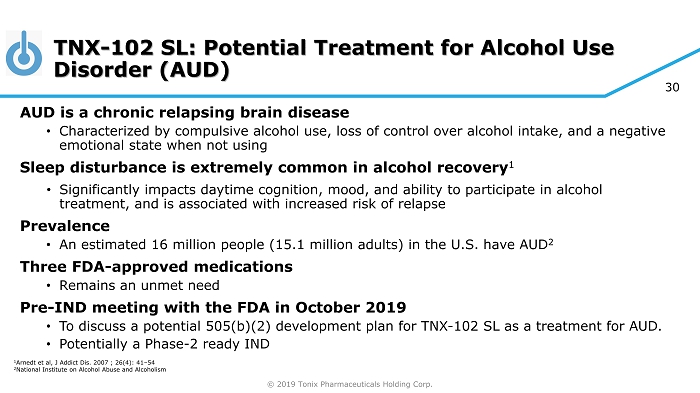
© 2019 Tonix Pharmaceuticals Holding Corp. 30 TNX - 102 SL: Potential Treatment for Alcohol Use Disorder (AUD) AUD is a chronic relapsing brain disease • Characterized by compulsive alcohol use, loss of control over alcohol intake, and a negative emotional state when not using Sleep disturbance is extremely common in alcohol recovery 1 • Significantly impacts daytime cognition, mood, and ability to participate in alcohol treatment, and is associated with increased risk of relapse Prevalence • An estimated 16 million people (15.1 million adults) in the U.S. have AUD 2 Three FDA - approved medications • Remains an unmet need Pre - IND meeting with the FDA in October 2019 • To discuss a potential 505(b)(2) development plan for TNX - 102 SL as a treatment for AUD. • Potentially a Phase - 2 ready IND 1 Arnedt et al, J Addict Dis. 2007 ; 26(4): 41 – 54 2 National Institute on Alcohol Abuse and Alcoholism
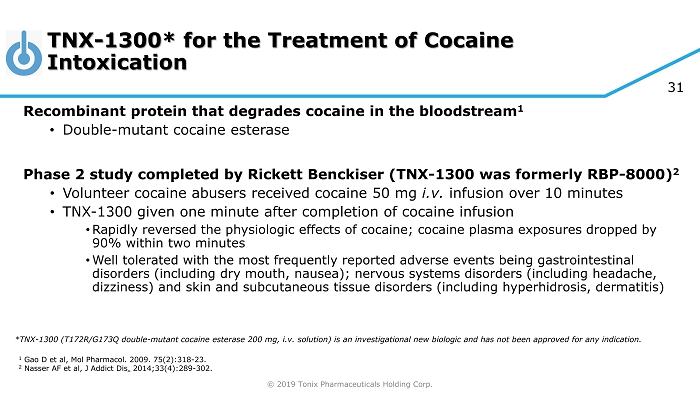
© 2019 Tonix Pharmaceuticals Holding Corp. 31 TNX - 1300* for the Treatment of Cocaine Intoxication Recombinant protein that degrades cocaine in the bloodstream 1 • Double - mutant cocaine esterase Phase 2 study completed by Rickett Benckiser (TNX - 1300 was formerly RBP - 8000) 2 • Volunteer cocaine abusers received cocaine 50 mg i.v. infusion over 10 minutes • TNX - 1300 given one minute after completion of cocaine infusion • Rapidly reversed the physiologic effects of cocaine; cocaine plasma exposures dropped by 90% within two minutes • Well tolerated with the most frequently reported adverse events being gastrointestinal disorders ( including dry mouth, nausea); nervous systems disorders (including headache, dizziness) and skin and subcutaneous tissue disorders (including hyperhidrosis , dermatitis) *TNX - 1300 (T172R/G173Q double - mutant cocaine esterase 200 mg, i.v. solution) is an investigational new biologic and has not been approved for any indication. 1 Gao D et al, Mol Pharmacol . 2009. 75(2):318 - 23. 2 Nasser AF et al, J Addict Dis . 2014;33(4):289 - 302.
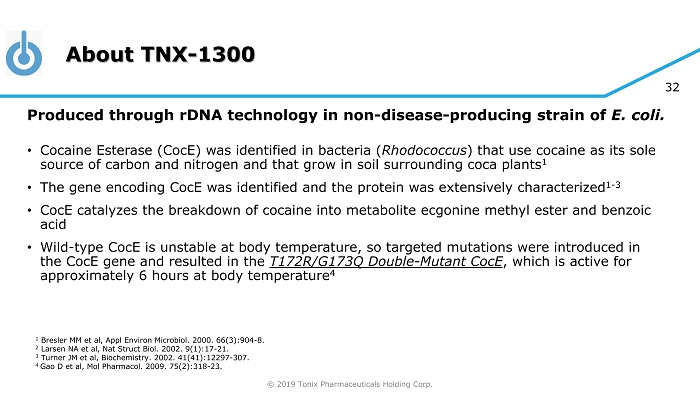
© 2019 Tonix Pharmaceuticals Holding Corp. 32 About TNX - 1300 Produced through rDNA technology in non - disease - producing strain of E. coli. • Cocaine Esterase ( CocE ) was identified in bacteria ( Rhodococcus ) that use cocaine as its sole source of carbon and nitrogen and that grow in soil surrounding coca plants 1 • The gene encoding CocE was identified and the protein was extensively characterized 1 - 3 • CocE catalyzes the breakdown of cocaine into metabolite ecgonine methyl ester and benzoic acid • Wild - type CocE is unstable at body temperature, so targeted mutations were introduced in the CocE gene and resulted in the T172R/G173Q Double - Mutant CocE , which is active for approximately 6 hours at body temperature 4 1 Bresler MM et al, Appl Environ Microbiol. 2000. 66(3):904 - 8. 2 Larsen NA et al, Nat Struct Biol. 2002. 9(1):17 - 21. 3 Turner JM et al, Biochemistry. 2002. 41(41):12297 - 307. 4 Gao D et al, Mol Pharmacol . 2009. 75(2):318 - 23.
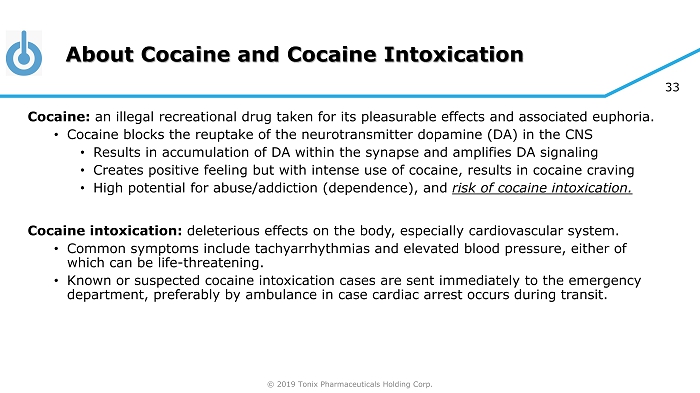
© 2019 Tonix Pharmaceuticals Holding Corp. 33 About Cocaine and Cocaine Intoxication Cocaine: an illegal recreational drug taken for its pleasurable effects and associated euphoria. • Cocaine blocks the reuptake of the neurotransmitter dopamine (DA) in the CNS • Results in accumulation of DA within the synapse and amplifies DA signaling • Creates positive feeling but with intense use of cocaine, results in cocaine craving • High potential for abuse/addiction (dependence), and risk of cocaine intoxication. Cocaine intoxication: deleterious effects on the body, especially cardiovascular system. • Common symptoms include tachyarrhythmias and elevated blood pressure, either of which can be life - threatening. • Known or suspected cocaine intoxication cases are sent immediately to the emergency department, preferably by ambulance in case cardiac arrest occurs during transit.
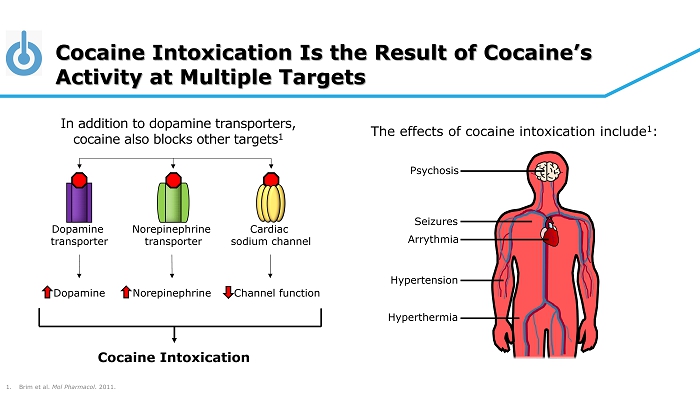
Cocaine Intoxication Is the Result of Cocaine’s Activity at Multiple Targets 1. Brim et al. Mol Pharmacol . 2011. Psychosis Seizures Arrythmia Hypertension Hyperthermia The effects of cocaine intoxication include 1 : In addition to dopamine transporters, cocaine also blocks other targets 1 Dopamine transporter Norepinephrine transporter Cardiac sodium channel Cocaine Intoxication Dopamine Norepinephrine Channel function

© 2019 Tonix Pharmaceuticals Holding Corp. 35 Pharmacotherapies for Cocaine Intoxication Have Not Been Effective 1. Brim et al. Mol Pharmacol . 2011. 2. Melichar et al. Eur J Phamacol . 2003. 3. Narasimhan et al. Future Medicinal Chemistry. 2012. Opiates Simple; mediated by opioid receptors 2 Agonists 2 Naloxone 2 Cocaine MOA of Toxicity Complex; mediated by multiple targets with distinct biological functions 1 Pharmacology Antagonist 1 Pharmacotherapy No FDA - approved medication exists 1 Dopamine transporter Norepinephrine transporter Cardiac sodium channel Cocaine Opiate Opioid receptor Naloxone Treatments for opiates not effective for cocaine:

© 2019 Tonix Pharmaceuticals Holding Corp. 36 TNX - 1300 (Cocaine Esterase or CocE ) Is a Fast - acting Cocaine Antidote CocE Rhodococcus bacteria living in the roots of the coca plant use CocE to metabolize cocaine 1 CocE cleaves chemical bonds in cocaine and disintegrates it 800 times faster than the rate that naturally occurs in the human body 1 Cocaine Cocaine is derived from the coca plant 1 1. Narasimhan D et al. Future Med Chem . 2012. Coca plant

© 2019 Tonix Pharmaceuticals Holding Corp. 37 TNX - 1300 cleaves cocaine in humans and removes it from the blood circulation 1 (N=29) Time Required to Return to Baseline (minutes) 120 0 240 Pulse Rate Diastolic Blood Pressure Systolic Blood Pressure 60 180 Time (minutes) 120 240 0 Cocaine Plasma Concentration (ng/ml) TNX - 1300 accelerates recovery from cocaine intoxication without inducing serious side effects 1 TNX - 1300 (CocE) Accelerates Recovery From Cocaine Intoxication in Humans Cocaine + TNX - 1300 Cocaine + Placebo Cocaine + Placebo Cocaine + TNX - 1300 Cocaine is administered TNX - 1300 is administered Note: Figures are for illustrative purposes 1. Nasser A et al. J Addict Dis. 2014. Cocaine is administered 0.1 0.001 10 0.01 1 100 1000 Below limits of detection for cocaine
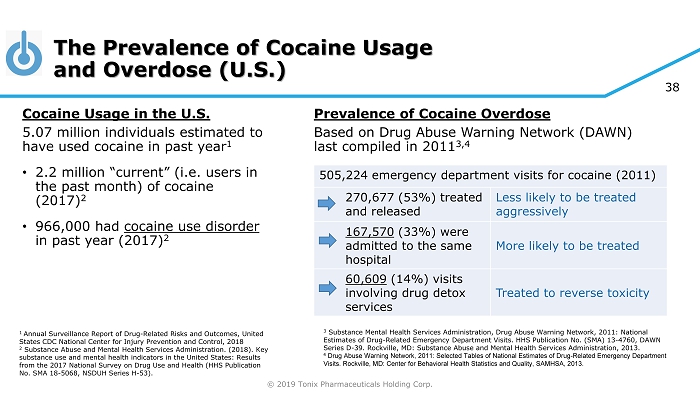
© 2019 Tonix Pharmaceuticals Holding Corp. 38 The Prevalence of Cocaine Usage and Overdose (U.S.) Cocaine Usage in the U.S. 5.07 million individuals estimated to have used cocaine in past year 1 • 2.2 million “current” (i.e. users in the past month) of cocaine (2017) 2 • 966,000 had cocaine use disorder in past year (2017) 2 1 Annual Surveillance Report of Drug - Related Risks and Outcomes, United States CDC National Center for Injury Prevention and Control, 2018 2 Substance Abuse and Mental Health Services Administration. (2018). Key substance use and mental health indicators in the United States: Results from the 2017 National Survey on Drug Use and Health (HHS Publication No. SMA 18 - 5068, NSDUH Series H - 53). Prevalence of Cocaine Overdose Based on Drug Abuse Warning Network (DAWN) last compiled in 2011 3,4 505,224 emergency department visits for cocaine (2011) 270,677 (53%) treated and released Less likely to be treated aggressively 167,570 (33%) were admitted to the same hospital More likely to be treated 60,609 (14%) visits involving drug detox services Treated to reverse toxicity 3 Substance Mental Health Services Administration, Drug Abuse Warning Network, 2011: National Estimates of Drug - Related Emergency Department Visits. HHS Publication No. (SMA) 13 - 4760, DAWN Series D - 39. Rockville, MD: Substance Abuse and Mental Health Services Administration, 2013. 4 Drug Abuse Warning Network, 2011: Selected Tables of National Estimates of Drug - Related Emergency Department Visits. Rockville, MD: Center for Behavioral Health Statistics and Quality, SAMHSA, 2013.

Cocaine Intoxication Is a Growing Problem in the U.S. National Drug Overdose Deaths Involving Cocaine 0 5000 10000 15000 Cocaine is involved in more emergency department (ED) visits than any other illicit substance 1 Drug overdose deaths involving cocaine have increased dramatically in recent years 2 1. CBHSQ. DAWN 2011. Rockville, MD: SAMHSA; 2013 2. NIDA. Overdose death rates. https://www/drugabuse.gov/related - topics/trends - statistics/overdose - death - rates. Note: Figures are for illustrative purposes Rate of ED Visits Involving Illicit Drugs per 100,000 People 0 100 200 21% of all emergency department (ED) visits involve cocaine
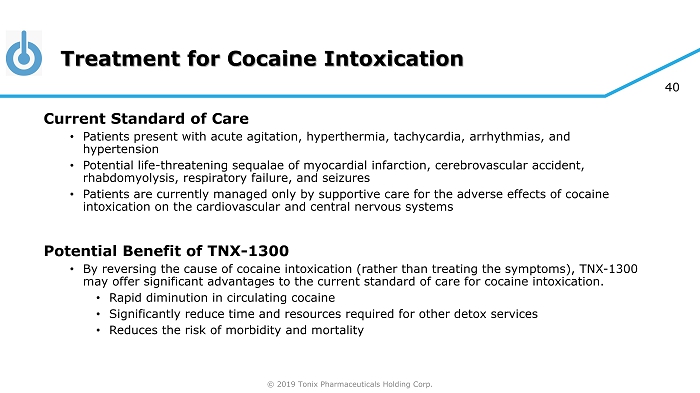
© 2019 Tonix Pharmaceuticals Holding Corp. 40 Treatment for Cocaine Intoxication Current Standard of Care • Patients present with acute agitation, hyperthermia, tachycardia, arrhythmias, and hypertension • Potential life - threatening sequalae of myocardial infarction, cerebrovascular accident, rhabdomyolysis, respiratory failure, and seizures • Patients are currently managed only by supportive care for the adverse effects of cocaine intoxication on the cardiovascular and central nervous systems Potential Benefit of TNX - 1300 • By reversing the cause of cocaine intoxication (rather than treating the symptoms), TNX - 1300 may offer significant advantages to the current standard of care for cocaine intoxication. • Rapid diminution in circulating cocaine • Significantly reduce time and resources required for other detox services • Reduces the risk of morbidity and mortality
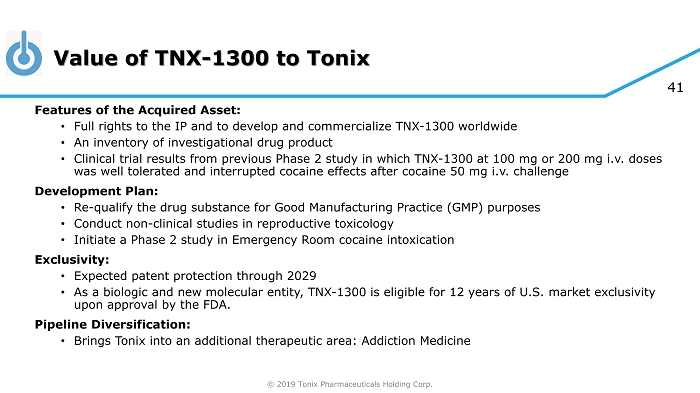
© 2019 Tonix Pharmaceuticals Holding Corp. 41 Value of TNX - 1300 to Tonix Features of the Acquired Asset: • Full rights to the IP and to develop and commercialize TNX - 1300 worldwide • An inventory of investigational drug product • Clinical trial results from previous Phase 2 study in which TNX - 1300 at 100 mg or 200 mg i.v. doses was well tolerated and interrupted cocaine effects after cocaine 50 mg i.v. challenge Development Plan: • Re - qualify the drug substance for Good Manufacturing Practice (GMP) purposes • Conduct non - clinical studies in reproductive toxicology • Initiate a Phase 2 study in Emergency Room cocaine intoxication Exclusivity: • Expected patent protection through 2029 • As a biologic and new molecular entity, TNX - 1300 is eligible for 12 years of U.S. market exclusivity upon approval by the FDA. Pipeline Diversification: • Brings Tonix into an additional therapeutic area: Addiction Medicine
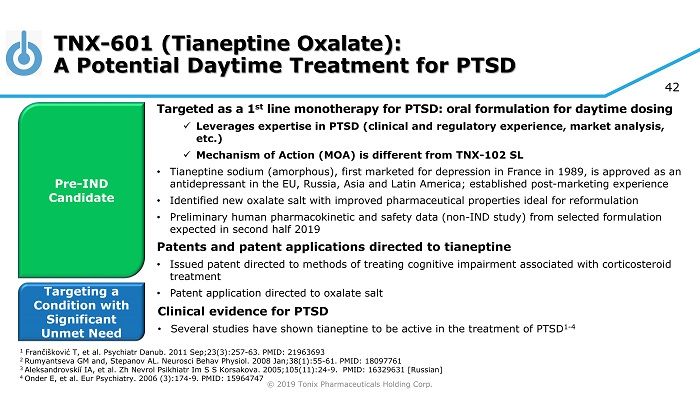
© 2019 Tonix Pharmaceuticals Holding Corp. 42 TNX - 601 (Tianeptine Oxalate): A Potential Daytime Treatment for PTSD Pre - IND Candidate Targeted as a 1 st line monotherapy for PTSD: oral formulation for daytime dosing x Leverages expertise in PTSD (clinical and regulatory experience, market analysis, etc.) x Mechanism of Action (MOA) is different from TNX - 102 SL • Tianeptine sodium (amorphous), first marketed for depression in France in 1989, is approved as an antidepressant in the EU, Russia, Asia and Latin America; established post - marketing experience • Identified new oxalate salt with improved pharmaceutical properties ideal for reformulation • Preliminary human pharmacokinetic and safety data (non - IND study) from selected formulation expected in second half 2019 Patents and patent applications directed to tianeptine • Issued patent directed to methods of treating cognitive impairment associated with corticosteroid treatment • Patent application directed to oxalate salt Targeting a Condition with Significant Unmet Need Clinical evidence for PTSD • Several studies have shown tianeptine to be active in the treatment of PTSD 1 - 4 1 Frančišković T, et al. Psychiatr Danub . 2011 Sep;23(3):257 - 63. PMID: 21963693 2 Rumyantseva GM and, Stepanov AL. Neurosci Behav Physiol. 2008 Jan;38(1):55 - 61. PMID: 18097761 3 Aleksandrovskiĭ IA, et al. Zh Nevrol Psikhiatr Im S S Korsakova . 2005;105(11):24 - 9. PMID: 16329631 [Russian] 4 Onder E, et al. Eur Psychiatry. 2006 (3):174 - 9. PMID: 15964747
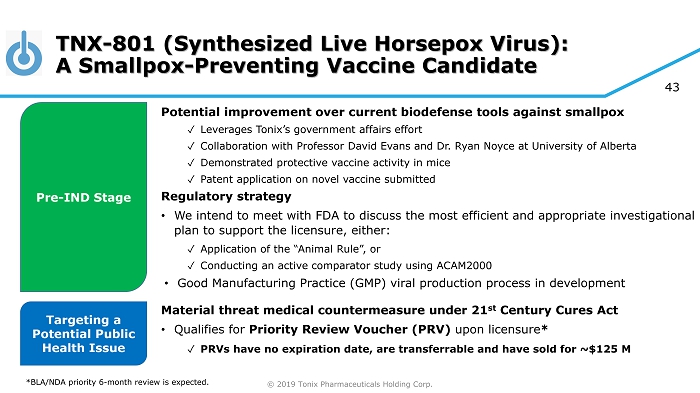
© 2019 Tonix Pharmaceuticals Holding Corp. 43 TNX - 801 (Synthesized Live Horsepox Virus): A Smallpox - Preventing Vaccine Candidate Pre - IND Stage Potential improvement over current biodefense tools against smallpox ✓ Leverages Tonix’s government affairs effort ✓ Collaboration with Professor David Evans and Dr. Ryan Noyce at University of Alberta ✓ Demonstrated protective vaccine activity in mice ✓ Patent application on novel vaccine submitted Regulatory strategy • We intend to meet with FDA to discuss the most efficient and appropriate investigational plan to support the licensure, either: ✓ Application of the “Animal Rule”, or ✓ Conducting an active comparator study using ACAM2000 • Good Manufacturing Practice (GMP) viral production process in development Targeting a Potential Public Health Issue Material threat medical countermeasure under 21 st Century Cures Act • Qualifies for Priority Review Voucher (PRV) upon licensure * ✓ PRVs have no expiration date, are transferrable and have sold for ~$125 M *BLA/NDA priority 6 - month review is expected.

© 2019 Tonix Pharmaceuticals Holding Corp. 44 T NX - 1500 (Anti - CD154 Monoclonal Antibody): Candidate to Prevent and Treat Organ Transplant Rejection and Treat Autoimmune Conditions Pre - IND Stage Third generation anti - CD154 mAB with potential improvement over first and second generations in terms of efficacy and decreased risk for thrombosis ✓ Leverages Tonix’s internal expertise in monoclonal antibody discovery and characterization ✓ Collaboration with Massachusetts General Hospital (MGH), a teaching hospital of Harvard Medical School, to develop TNX - 1500 Other autoimmune conditions that TNX - 1500 could potentially treat include: • Systemic lupus erythematosus, rheumatoid arthritis and multiple sclerosis Significant unmet need for improved activity and tolerability Risk mitigated by extensive preclinical science • A substantial body of evidence in humans and animals indicates that mAbs targeting CD154 have the potential to be an important therapeutic option for preventing or treating transplant organ rejection and as a treatment for autoimmune disorders Existing mABs • First generation anti - CD154 mAbs were limited because their constant fragment (Fc) domain interacted with a receptor called FcγRII , which raised concerns over an increased risk of thrombosis • Second generation anti - CD154 mAbs had dramatically reduced binding to FcγRII , but had other issues, including decreased efficacy 1 - 3 1 Waters J, Biocentury ; October 26, (2018) 2 NCT02273960; ClinicalTrials.gov; “Study to Evaluate Safety and Efficacy in Adult Subjects With ITP (ITP)”; results posted A pri l 1, 2019, accessed July 29, 2019) 3 Ferrant JL et al., International Immunol. (11):1583 (2004)
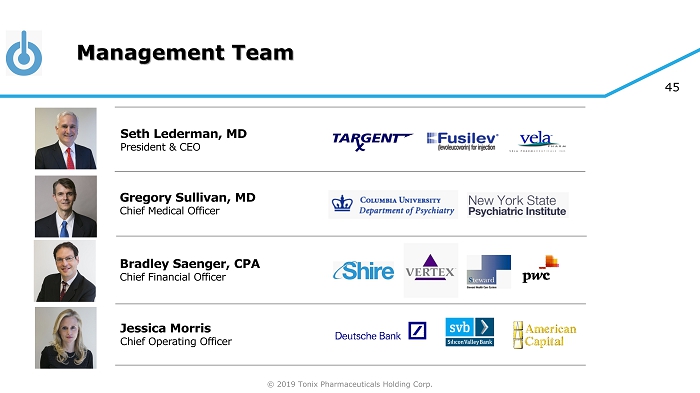
© 2019 Tonix Pharmaceuticals Holding Corp. 45 Management Team Seth Lederman, MD President & CEO Jessica Morris Chief Operating Officer Gregory Sullivan, MD Chief Medical Officer Bradley Saenger, CPA Chief Financial Officer

© 2019 Tonix Pharmaceuticals Holding Corp. 46 Board of Directors Seth Lederman, MD Chairman Adeoye “Oye” Olukotun, MD Squibb, BMS, Mallinckrodt, Esperion John Rhodes Chair, NYS Public Service Commission, CEO, NYS Dept. of Public Service, Booz Allen James Treco First Chicago, Salomon Brothers/Citigroup Brig. General David Grange (U.S. Army, ret.) Pharm - Olam, PPD, McCormick Foundation Margaret Smith Bell Standard Life Investments, Putnam Investments, State Street Research Daniel Goodman, MD Psychiatrist, co - founder Psychogenics
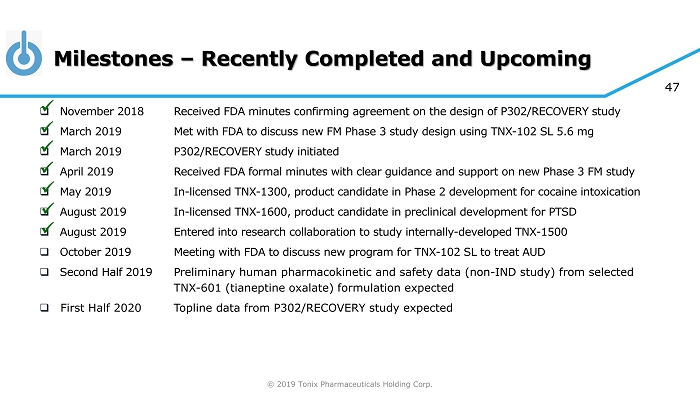
© 2019 Tonix Pharmaceuticals Holding Corp. 47 Milestones – Recently Completed and Upcoming □ November 201 8 Received FDA minutes confirming agreement on the design of P302/RECOVERY study □ March 2019 Met with FDA to discuss new FM Phase 3 study design using TNX - 102 SL 5.6 mg □ March 2019 P302/RECOVERY study initiated □ April 2019 Received FDA formal minutes with clear guidance and support on new Phase 3 FM study □ May 2019 In - licensed TNX - 1300, product candidate in Phase 2 development for cocaine intoxication □ August 2019 In - licensed TNX - 1600, product candidate in preclinical development for PTSD □ August 2019 Entered into research collaboration to study internally - developed TNX - 1500 □ October 2019 Meeting with FDA to discuss new program for TNX - 102 SL to treat AUD □ Second Half 2019 P reliminary human pharmacokinetic and safety data (non - IND study) from selected TNX - 601 (tianeptine oxalate) formulation expected □ First Half 2020 Topline data from P302/RECOVERY study expected x x x x x x x
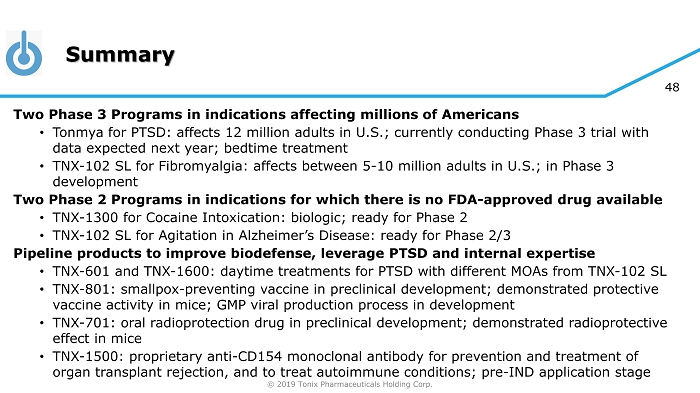
© 2019 Tonix Pharmaceuticals Holding Corp. 48 Summary Two Phase 3 Programs in indications affecting millions of Americans • Tonmya for PTSD: affects 12 million adults in U.S.; currently conducting Phase 3 trial with data expected next year; bedtime treatment • TNX - 102 SL for Fibromyalgia: affects between 5 - 10 million adults in U.S.; in Phase 3 development Two Phase 2 Programs in indications for which there is no FDA - approved drug available • TNX - 1300 for Cocaine Intoxication: biologic; ready for Phase 2 • TNX - 102 SL for Agitation in Alzheimer’s Disease: ready for Phase 2/3 Pipeline products to improve biodefense, leverage PTSD and internal expertise • TNX - 601 and TNX - 1600: daytime treatments for PTSD with different MOAs from TNX - 102 SL • TNX - 801: smallpox - preventing vaccine in preclinical development; demonstrated protective vaccine activity in mice; GMP viral production process in development • TNX - 701: oral radioprotection drug in preclinical development; demonstrated radioprotective effect in mice • TNX - 1500: proprietary anti - CD154 monoclonal antibody for prevention and treatment of organ transplant rejection, and to treat autoimmune conditions; pre - IND application stage

© 2019 Tonix Pharmaceuticals Holding Corp. 49 Thank you ! NASDAQ: TNXP